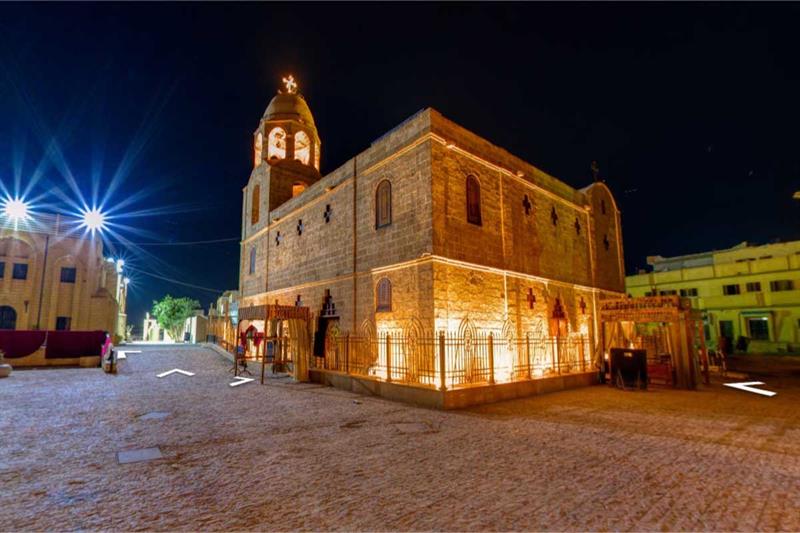Ministry of Tourism launches virtual tour of sacred Gebel El-Teir area in Egypt
Nevine El-Aref , Monday 9 Oct 2023
To promote the Holy Family journey in Egypt, the Ministry of Tourism and Antiquities launched a virtual tour of the Gebel El-Teir area in Minya, one of the points where the Holy Family stopped on their journey through Egypt.

Amr El-Kady, CEO of the Egyptian Tourism Authority, said the tour also showcases the Ministry of Tourism and Antiquities' efforts to restore and develop Gebel El-Teir as part of the ministry's plan to redevelop the points where the Holy Family stopped during their journey in Egypt.
El-Kady added that the tourism ministry also plans to raise the efficiency of services provided to the visitors of these points within the framework of the "Revival of the Holy Family Journey in Egypt" project.
"Available in English and Arabic, this tour will allow Egyptians and foreigners to virtually tour the Gebel El-Teir area in Minya, which the Holy Family passed through during their trip in Egypt," he explained.
The tour can be viewed on the social media pages of the ministry and the authority.
The Holy Family stopped at 25 points over the course of their 3500‑meter journey from Assiut to Sinai. The family first came through Rafah in North Sinai, passing through El-Farama, east of Port Said. Then, they passed through Sakha in Kafr El-Sheikh, Tel Basta in Sharqiya, and Samanoud in Gharbiya. From there, they moved to Wadi El-Natroun in the Western Desert, where the Monasteries of Anba Bishoy, Virgin Mary, El‑Surian (the Monastery of the Syrians), Paramus, and St. Abu Maqqar would eventually be founded.
The journey then took them to Bab Zuweila in Fatimid Cairo, where the churches of Abu Serga (Saint Sergius) and Bacchus are located. After that, they moved to Maadi, where they crossed the Nile, arriving in Gebel El-Teir in Minya in Upper Egypt. Then they proceeded to Assiut, where El-Maharaq Monastery is located. From there, they went on to stay in the Dronka cave before returning to Bethlehem.
The Ministry of Tourism and Antiquities and the Ministry of Local Development have started a project to revive the points at which the Holy Family stopped during their journey in Egypt, beginning with upgrading the quality of the services offered to visitors.
The ministries have improved the Holy Family's stops in Sakha in Kafr El-Sheikh, Tel Basta in Sharqiya, and Samanoud in Gharbiya.
They have also developed the Monastery of Wadi El-Natroun in Beheira and Gebel El-Teir in Minya.
Furthermore, they developed the area surrounding the Tree of the Virgin Mary in Matariya in Cairo.
The project also aims to develop poorer areas and communities in the Delta and Upper Egypt and restore archaeological sites.
The Holy Family visited Gebel El-Teir and stayed for three days during their journey in Egypt.
The government has allocated LE 7.5 million for developing the area of Gebel El-Teir through upgrading facilities and building infrastructure to make it more appealing to visitors who would like to retrace the path the Holy Family took during their sojourn in Egypt.
Roads that lead to Gebel El-Teir Church have been extended and paved, sunshades, seats, and signage have been installed, and landscaping work has been done on the area surrounding the monastery.
Abu Bakr Abdalla, head of the Islamic, Coptic, and Jewish Antiquities Sector at the Supreme Council of Antiquities, said the Church of the Virgin Mary at Gebel El-Teir was built in 328 CE by the Byzantine empress Helena, mother of the emperor Constantine, to commemorate the passage of the Holy Family in Egypt.
In 1938, Severus, the bishop of Minya, restored the church and enlarged it by removing the original stone roof.
The church consists of a nave with three sanctuaries, two side aisles, and a western return aisle separated by 10 rock-cut columns. On the south side of the church, the baptismal font is carved out of a column. The area in front of the middle sanctuary serves as a choir.
Hisham Samir, Assistant to the Minister of Tourism and Antiquities for Archaeological Projects, said the project for restoring the monastery and the church began in 2018 and included restoring the church's walls and ceiling, removing cracks, consolidating the walls, and repairing the bell in the tower in addition to the church's four arcades and domes.
The façades of the church have been mechanically cleaned, and the modern mosaic, set up in 1987 on the eastern wall of its southern entrance, has been replaced with another showing the journey of the Holy Family.
-- Sent from my Linux system.
No comments:
Post a Comment